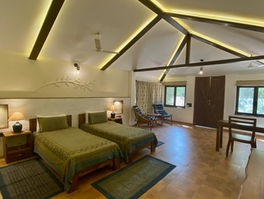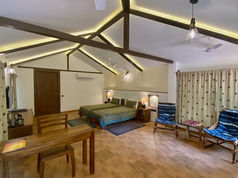Archaeological Wonders of Gujarat
Duration: 12 Days
Best Time to Travel: October to March
Highlights: Modhera Sun Temple (11th-century architectural marvel)
Rani ki Vav, Patan (UNESCO‑listed 11th-century stepwell)
Taranga Jain Temples and historic Vadnagar
Champaner‑Pavagadh Archaeological Park (Indo‑Saracenic heritage)
Lesser-known gems: Khambhalida Caves (4th‑5th century Buddhist), Junagadh forts & palaces
Harappan sites: Dholavira (UNESCO, Indus‑Valley city), possibly Gola Dhoro and Lothal
Itinerary Route: Ahmedabad → Modhera → Patan → Siddhpur → Balaram → Taranga → Vadnagar → Ahmedabad → Champaner/Pavagadh → Vadodara/Ahmedabad
DAY 01
Arrival in Ahmedabad: The Indo-Islamic Cradle
Arrive in Ahmedabad and check in at The House of MG, a landmark heritage mansion that reflects the city’s textile-era grandeur.
Your journey begins at Sarkhej Roza, an architectural ensemble of mausoleums, mosques, and palaces. A forerunner of Mughal aesthetics, this site embodies the perfect synthesis of Hindu, Jain, and Islamic motifs—a geometric elegance enhanced by native craftsmanship. Sarkhej embodies the Sultanate’s earliest vision of a unified spiritual and civic space.
Arrive in Ahmedabad and check in at The House of MG, a landmark heritage mansion that reflects the city’s textile-era grandeur.
Later, visit the Vechaar Utensils Museum at Vishalla Village. It’s the world’s only museum dedicated solely to traditional utensils, showcasing not just utility but the artisanal design sense of pre-industrial Gujarat.
(Closed Mondays; open 3 PM–10:30 PM)
Stay: The House of MG.
DAY 02
Textile to Stone: Ahmedabad’s Layers of Legacy
Begin your day by visiting the Adalaj Stepwell, a 15th-century marvel built by Queen Rudabai.
This five-story octagonal well showcases ornate carvings, symbolic geometry, and a fusion of sacred and civic space. More than a water source, it's a temple of life and resilience.
Later in the afternoon, Calico Museum of Textiles (Closed Monday and Public Holidays), one of the finest repositories of Indian textile heritage. Its rare collections include 15th-century Egyptian trade swatches, Patola ikats, Mughal tents, chintz for European markets, and temple cloths that double as storytelling epics.
Arrive in Ahmedabad and check in at The House of MG, a landmark heritage mansion that reflects the city’s textile-era grandeur.
End the day at the iconic Sidi Saiyyed Mosque, famed for its “Tree of Life” jaali—an enduring symbol of Ahmedabad. Built in the last days of the Gujarat Sultanate (1573), this mosque is both an aesthetic and emotional centrepiece of the city.
Conclude your evening with local food and atmosphere at Manek Chowk, where the walled city comes alive with street food, silver merchants, and centuries-old bazaars.
Stay: The House of MG
DAY 03
Heritage Walk, Harappan Precision, and Jain Devotion
At dawn, begin a guided heritage walk from Swaminarayan Temple Kalupur, through the Pols—Ahmedabad’s medieval residential labyrinths.
Marvel at intricately carved wooden havelis, bird feeders (chabutras), and secret passages that speak of both defence and community harmony.
After breakfast, drive to Lothal (closed Fridays)—one of the world’s oldest dockyards. The site museum and excavated township provide a rare glimpse into the maritime engineering and urban grid planning of the Indus Valley Civilization.
By late afternoon, continue to Palitana, the Jain spiritual capital. Check in at Vijay Vilas Heritage Hotel, located in Adipur village.
DAY 04
Palitana – Sacred Summit of Shatrunjaya
Begin your day early with an ascent of Shatrunjaya Hill, one of Jainism’s most sacred pilgrimage sites.
The hill is crowned with a breathtaking complex of 863 exquisitely carved Jain temples built over centuries in pristine white marble. The temples rise in quiet grandeur, echoing the devotion of countless generations of Jain pilgrims.
As you walk the 3,800 steps, the panoramic views unfold across the town of Palitana and the Shetrunji River. At the summit, temples like the Adinath Temple, dedicated to the first Jain Tirthankara, showcase sublime artistry and intricate domes, spires, and latticework.
Return for a restful evening at Vijay Vilas, a heritage residence in Adpur village, where old-world charm and local hospitality immerse you in the region’s princely past.
Arrive in Ahmedabad and check in at The House of MG, a landmark heritage mansion that reflects the city’s textile-era grandeur.
DAY 05
Palitana – Gondal: Palaces and Craftsmanship
After breakfast, drive towards Gondal, a town known for its royal heritage and refined architecture. En route, take in rural Gujarat’s pastoral landscapes dotted with ox carts and ornate village shrines.
In Gondal, visit the Naulakha Palace, built in the 1740s. With its stone carvings, delicate jharokhas, and pillared courtyards, the palace reflects both Rajput and colonial aesthetics. The royal collection includes vintage cars, silver artifacts, and hand-crafted textiles.
Stay at either the Riverside Palace or Orchard Palace, charming heritage hotels once used by the royal family. These properties preserve Gondal’s regal legacy with antique furniture, portraits, and old-world elegance.
Arrive in Ahmedabad and check in at The House of MG, a landmark heritage mansion that reflects the city’s textile-era grandeur.
DAY 06
Gondal – Junagadh – Khambhalida – Gondal
Today, take a full-day excursion to Junagadh, one of Gujarat’s oldest and most historic cities. Start at the Uparkot Fort, a citadel with 2,000 years of layered history—Buddhist caves, a Neolithic well, and later Mauryan and Islamic additions.
Next, see the Maqbara complex, the flamboyant 19th-century mausoleums of the Nawabs of Junagadh, designed in an Indo-European style with onion domes, spiral staircases, and delicate metal filigree work.
Ride the Girnar ropeway to visit ancient Jain and Hindu temples atop Mount Girnar, where spirituality meets sublime stonework. Return via Khambhalida Caves, a group of 4th-century Buddhist rock-cut caves nestled among lush greenery—an overlooked gem of Gujarat’s early spiritual landscape.
Evening return to Gondal
DAY 07
Gondal – Dholavira: Into the Harappan Heartland
After an early breakfast, drive towards Dholavira, a remote archaeological wonder located in the Great Rann of Kutch. Stop at Maliya for refreshments before continuing across salt flats and arid wilderness landscapes that transport you back thousands of years.
Check into the Dholavira Tourism Resort. Enjoy a quiet evening under the stars. The isolation here evokes the same stark beauty that once framed one of the world’s earliest urban centres.
Arrive in Ahmedabad and check in at The House of MG, a landmark heritage mansion that reflects the city’s textile-era grandeur.
DAY 08
Dholavira – Dasada: Engineering of the Ancients
Begin the day with a guided tour of Dholavira, the largest excavated site of the Indus Valley Civilization in India. Dating back over 4,500 years, Dholavira showcases remarkable urban planning, a complex water conservation system, and vast reservoirs—evidence of advanced civil engineering.
The layout reveals a citadel, middle town, lower town, and a ceremonial ground that hints at social hierarchy and urban function. The site’s ingenious rainwater harvesting system—wells, terracotta pipes, and check dams—speaks to the people’s resilience in a changing climate.
After lunch, drive to Dasada, near the Little Rann of Kutch, and check into Rann Riders Resort, an eco-lodge blending rustic charm with comfort.
Arrive in Ahmedabad and check in at The House of MG, a landmark heritage mansion that reflects the city’s textile-era grandeur.
DAY 09
Dasada – Modhera – Patan – Balaram
After breakfast, journey to the Sun Temple of Modhera, built in the 11th century by King Bhima I of the Solanki dynasty.
Designed in alignment with the solar equinox, the temple is one of the finest examples of Chalukyan temple architecture, renowned for its elaborately carved Surya Kund (stepwell), toranas, and friezes.
Continue to Patan, the historic Solanki capital, to visit the Rani ki Vav, a UNESCO World Heritage Site. This 11th-century stepwell is a subterranean marvel with seven levels of sculptures and galleries, representing deities, celestial beings, and mythological scenes.
Drive onward through Siddhpur, known for its pastel-colored Dawoodi Bohra havelis, and arrive at Balaram Palace Resort, once the hunting retreat of the Lohanis of Palanpur.
Arrive in Ahmedabad and check in at The House of MG, a landmark heritage mansion that reflects the city’s textile-era grandeur.
DAY 10
Balaram – Taranga – Vadnagar – Ahmedabad
Depart for the Taranga Hills to visit the magnificent 12th-century Jain temples, especially the Ajitnath Temple, known for its symmetry and carving finesse. The site is serene, nestled amid wooded hills, offering spiritual respite and architectural richness.
Next, visit Vadnagar, the ancient Anarta capital, with a lineage spanning over 2,500 years. Highlights include the Hatkeshwar Mahadev Temple, the torans of Kirti Toran, Buddhist relics, and ancient stepwells. Vadnagar's urban evolution from a Buddhist monastery town to a Shaivite pilgrimage site reflects Gujarat’s layered sacred geography.
Drive back to Ahmedabad, reaching by evening.
DAY 11
Ahmedabad – Champaner – Jambughoda
Embark on a full-day exploration of Champaner-Pavagadh Archaeological Park, a UNESCO World Heritage Site. This 16th-century capital of Sultan Mahmud Begada features an exceptional array of Indo-Islamic architecture, including Jami Masjid, with its minarets, lattice windows, and mihrabs carved in stunning detail.
The stepwells, palaces, and fortifications of Champaner are laid out dramatically across the lower slopes of the volcanic Pavagadh Hill, crowned by the ancient Kalika Mata Temple, a revered Shakti Peeth.
Continue to Jambughoda, a former princely state nestled in forested hills. Stay at a heritage home, where tribal traditions and royal hospitality meet.
DAY 12
Jambughoda – Return to Ahmedabad / Vadodara
Enjoy a leisurely breakfast in the forested surroundings of Jambughoda. Depending on your onward plans, drive to either Ahmedabad or Vadodara airport for your departure.
Your journey concludes with a profound understanding of Gujarat’s architectural, spiritual, and historical legacy, from ancient urban civilizations to Jain temple summits and Indo-Islamic splendours.
.png)































































































































































































































































































































